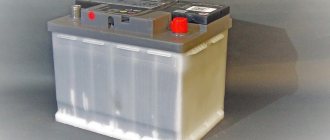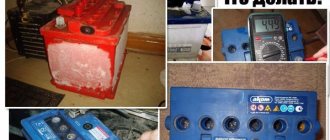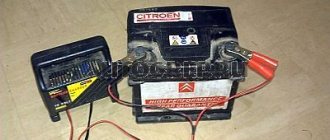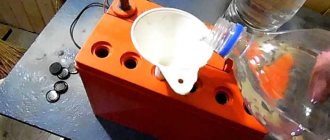Lead-acid car batteries store energy as long as a chemical reaction occurs between the electrolyte and the conductive plates. When the electrolyte density changes, this process is disrupted. It doesn’t matter why the electrolyte has deteriorated, the battery will not work. It is necessary to replace the electrolyte, adjust the density, or purchase a new battery. If the electrolyte has turned black and contains a suspension of coal and scale, the battery will have to be replaced.
Complete replacement of electrolyte in the battery
The electrolyte is a mixture of sulfuric acid and water in a certain proportion. The concentration of a solution is determined by the density measured by a hydrometer. The basic indicator, even hundredths, affects the ability of the electrolyte to work to store energy.
Signs of an unusable electrolyte:
- Measuring density on a charged battery with a hydrometer. The value should be 1.25 -1.27 g/cm3.
- A cloudy electrolyte is evidence that parasitic sulfation processes are taking place inside.
- The electrolyte froze, but the seal of the case was not broken.
- The solution is black or dark brown with a suspension of coal and scale.
Replacing the electrolyte in a battery will be effective when the cavities of the cans are examined, washed, and sulfate deposits are removed. If the plates are destroyed and the active substance has fallen off, the battery cannot be repaired.
At home, a complete replacement of the electrolyte in a car battery occurs in the following sequence:
- Prepare enamel or glass containers for draining the electrolyte, personal protective equipment, and a place to work, preferably outdoors.
- Remove the battery from the car, remove the plugs or drill holes in the maintenance-free battery, drain the liquid into a prepared container using a bulb or syringe.
- The battery is washed with distilled water several times until the sediment is removed. Lead sulfate may need to be removed if there is residue on the plates. You need to make sure that the active putty has not crumbled and that the coal grate is intact.
- Slowly, intermittently, pour the electrolyte of the required density into each jar 5-7 mm above the plates. Wait 2-3 hours for the bubbles to come out, measure the density of the electrolyte, bring it to normal
- After replacing the electrolyte, charge the battery with a low current of 0.1 A, avoiding boiling. After reaching half the capacity, charging is carried out cyclically.
- Seal the cans.
How long does it take to charge the battery? After replacing the electrolyte, you need to charge the battery carefully, as after a deep discharge. The operation of replacing the electrolyte with your own hands in a car battery is considered complete if it fully accepts current for a long time. Charging is carried out carefully; boiling in jars is unacceptable.
We invite you to watch a video on how to properly replace the electrolyte in a car battery.
Why you can’t add electrolyte to the battery
Have you measured the level in the battery banks, is it below normal? This means that some of the water has evaporated. If this is a serviceable battery, you need to measure the level in each jar and add electrolyte to the required level with water. In a maintenance-free battery, the bay mirror can be seen through the walls.
The level has dropped, which means there is little water in the solution and high density. The added electrolyte will raise the level, but the density of the solution will remain high. This is detrimental to the battery plates and shortens the battery life. Therefore, the electrolyte should be brought to the level by adding distilled water.
Watch a video about electrolyte replacement rules.
Closer to practice
If everything is clear with the definition of the problem, then the question arises: what is added to the battery - water or electrolyte? The result of measurements with a hydrometer will help with the answer: if the solution is too dense, then adding water will solve the problem. If the solution has too low a density, then you cannot do without an electrolyte.
Let's deal with water. Why is it so important to add distilled or, in extreme cases, melt water? The fact is that bottled water or tap water contains impurities that, when interacting with electricity, will at least produce sediment, and in worst cases will lead to complete deterioration of the battery. Therefore, the most purified water is necessary.
To add water, you will need an ordinary funnel, then charge the battery and re-check the density of the resulting mixture.
In what cases should electrolyte be added to the battery?
Electrolyte is added to the battery when the capacity decreases. At the same time, measurements of the contents of each jar with a hydrometer show a decrease in density. It is possible that sulfation has occurred in the battery; the bound acidic residue in PbSO4 does not participate in the reaction.
If the electrolyte extracted from the jars is transparent and light, it can be reused by adding a correction solution with a density of 1.4 g/cm3. After removing the sediment on the plates, the battery is filled with the same electrolyte, but it is of low concentration. Is it possible to bring the solution to the desired density by adding electrolyte? What composition should I take, and how much correction solution should I add to the battery?
According to the technology, you need to replace a portion of a weak composition with a strong one. You can add and remove the electrolyte solution from the jars using a bulb and a measuring cylinder. How to change solutions, in what proportion can be seen from the table.
In this case, only electrolyte should be used for correction. After the replacement operation, recharging is carried out for half an hour so that the liquids mix. Two hours after turning off the charger, the density is checked, if necessary, the adjustment is repeated.
We suggest you watch the video on how to add electrolyte to the battery.
Preparatory work
Before servicing the battery, you should study the instructions, which fully describe how to properly add electrolyte to the battery, and it is also important to read the charging instructions .
In order to properly add electrolyte to the battery, it is important to prepare the workplace where this operation will take place.
Also, do not neglect safety precautions:
- The first thing you need to do is put on overalls, which includes a set of pants, a jacket, rubberized gloves and safety glasses.
- Place the battery on the workbench and clean it of various dirt using a rag. The main attention should be paid to the positive and negative contacts.
- Check the battery with a multimeter.
- Carefully open the covers using a Phillips screwdriver.
This is interesting: How many liters of oil are in a Peugeot 3008 engine
What to add to the battery, water or electrolyte
Subject to operating conditions, maintenance-free batteries do not require monitoring the density and electrolyte level. Serviced batteries have special plugs - access to each bank. They are regularly checked for quality and electrolyte levels. The battery's energy reserve is determined by its weakest element. Therefore, it is necessary to maintain the electrolyte density in all banks equal.
The density in the jar may decrease if sulfation has begun. Then adding an electrolyte won't help. The strong resistance of the clogged plates does not allow the charge to pass through, the added acid will increase the deposits. In this case, the charge will restore sulfation. This is why you cannot add electrolyte to a battery with lead sulfate deposits.
Should I add water to the battery? If the electrolyte level in the banks is low, this indicates intense boiling of the battery during operation. Mostly hydrogen evaporates. Active putty may fall off from exposed plates, causing sulfation and corrosion. Therefore, it is necessary to add distilled water, but after this the battery must be charged for a full cycle.
During the period of capacity restoration, lead crystals are partially destroyed, the dense solution is diluted, and the activity of the electrolyte is restored. Add electrolyte or water to the battery into the holes covered with plugs using a small stream through a funnel. Charging does not begin immediately, so that the air escapes and the compounds are mixed.
Density control should be carried out half an hour after the charger is turned off. If there are density deviations, make corrections.
Let's sum it up
Extending the life of mechanisms and systems that are directly involved in the functioning of the vehicle is the desire of every car owner, since the purchase of any mechanism or accessory is an additional financial waste. In the case of a battery, experts and professionals strongly recommend not to experiment, especially if the existing device belongs to the category of budget products; if it fails, they advise buying a new battery. Attempts to restore the functioning of the battery by refilling it will only temporarily extend the operating life of the unit, so purchasing a new charger is inevitable. It’s better to immediately purchase a high-quality battery for your car, which, if used properly, will serve you for many years.
When to add electrolyte and when to add water?
The question is what to add if there is little electrolyte in the battery banks and requires special lighting. Liquids such as electrolyte or distilled water must be filled into the battery correctly. The body and funnel must be clean, the liquid being poured is transparent, without suspension. You can add electrolyte with water using a medical syringe without a needle if minor adjustments are required.
In what cases can you add water to the battery electrolyte? If in one or more banks the electrolyte level in the battery is low. This occurs due to the boiling of cans under conditions of elevated temperature or deep discharge. By adding distilled water, volume losses are compensated, the density of the electrolyte is reduced, and rapid wear of the battery is prevented.
Do I need to charge the battery after adding water or replacing the electrolyte? Any change in internal balance requires alignment and stabilization. After changing the concentration of the liquid, it is necessary to carry out a full charging cycle, make sure that the battery has not lost capacity, the voltage at the terminals is stable, and provides starting current.
Is it possible to add electrolyte to the battery if it accidentally spills out? How did it happen? The device may have been turned over. This is one of the few cases when the leaked electrolyte is replaced with exactly the same one and even the temperature is adjusted. But you will still need to recharge and check the density.
Watch the video on how to properly add electrolyte to the battery. Water or electrolyte, what should I add?
A little theory
The standard electrolyte density in batteries for central Russia is 1.25-1.30 g/cm. cube Ideally, if the indicator is 1.28 g/cc. see. If, for example, the battery freezes or boils, then the density of the electrolyte will change in one direction or the other, which will lead to the very rapid discharge of the battery. In this case, it is necessary to find the cause of the problem and eliminate it.
In your search, the main assistant will be a hydrometer - a special device with which the density of the electrolyte is determined.
A hydrometer that determines the density of the electrolyte
To use it, first of all, unscrew the round plug from each of the battery compartments, lower the device into the liquid and look at the resulting readings.
It is important to check each of the compartments!
It is also worth remembering that these manipulations are carried out on a device that is not working at the time of testing.
Another point - the liquid should cover the battery elements by 1–1.5 cm. If the fluid level is less, then topping it up is urgently necessary.
How to add electrolyte to a maintenance-free battery
Everything is much more complicated if you need to add water to the electrolyte of a maintenance-free car battery. Through the translucent walls you can see how much electrolyte is in the jars. But how to penetrate the casing of a maintenance-free battery?
There are models in which you can get inside by cutting off the top cover with a grinder. But such actions are necessary if you need to remove scale and wash out the sludge that has settled below. In order to add liquid to the required level, drill a hole in the housing. Later it is sealed with epoxy glue.
A completely maintenance-free battery requires careful handling, it is afraid of deep discharges and unstable operation of the on-board battery. It can withstand the stated 5-7 years only in ideal conditions.











